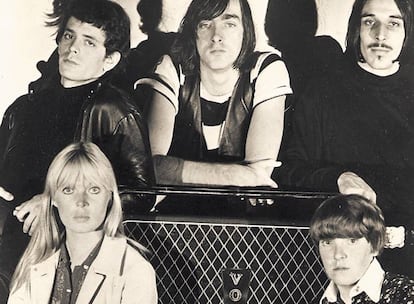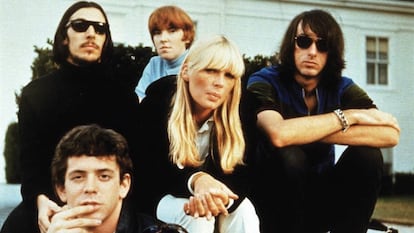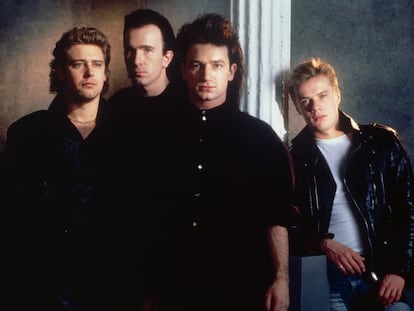The Velvet Underground: an inside look at the band that gave a voice to the outsiders
Film director Todd Haynes pays tribute to the influential US rockers with a documentary full of previously unseen footage
The importance of The Velvet Underground has been endlessly discussed. They are, with a nod to The Beatles, the modern rock group par excellence. Formed by Lou Reed and John Cale in New York in 1965, the band was immediately endorsed by Andy Warhol, with whom they would collaborate until 1967, although his influence would never leave them. The Velvet Underground were a sixties group that, during its five years of existence, failed to fit into their era for a single day. While others sung of love and good vibrations, they designed a revolutionary and perverse alternative for rock.
It was an alternative that remains valid to this day, half a century after the group was mortally wounded by the departure of Reed in August 1970. To corroborate this, Apple TV will premiere The Velvet Underground in October. Directed by Todd Haynes, the documentary is full of never-before-seen footage and interviews with people who were in the thick of it at the time, more than compensating for a dearth of movies about a band that can be described as legendary without fear of slipping into musical nepotism.

The documentary arrives in good company. At the end of September I’ll be your mirror: A tribute to The Velvet Underground & Nico was released, an album of cover versions of the group’s influential debut album when the line-up consisted of Reed, Cale, Sterling Morrison and Moe Tucker. A posthumous work by producer Hal Willner, who died of Covid-19 in 2020, it features contributions by Thurston Moore, Sharon van Etten, Iggy Pop, Kurt Vile, Courtney Barnett and Michael Stipe, among others.
Speaking about the original The Velvet Underground & Nico, released in 1967, Haynes said in an interview with Uncut magazine earlier this year that it is music that makes you think about how fragile identity is, and also about life. The journalist Susana Monteagudo concurs with Haynes. “The Velvet Underground were the first punk group in terms of transgression of codes and creative freedom,” says the author of books including Illustrated History of Rock and Amy Winehouse. Stranger than her. “As well as practicing the philosophy of do-it-yourself and rejecting the commercial course of the music industry, they subverted the establishment by making dissidence visible on every level, not just in artistic terms. They embraced the marginal and they were too nihilistic, cynical and sinister for the Flower Power era.”
The Velvet Underground did not belong to their time, but to the future. Cale wanted to fuse rock and roll with experimental music. Reed’s lyrics were open to the influence of writers like Burroughs, Delmore Schwartz and John Rechy. They were a loud and screeching band, but they also composed melodic songs. This contrast is most evident on The Velvet Underground & Nico, which contains some of the group’s most beautiful songs. I’ll be your mirror and Femme Fatale are sung by Nico (who also provides vocals on the chorus of Sunday morning, originally written for her but eventually sung by Reed), one of the most conflicting elements of the band.
For trans artist Roberta Marrero, Nico, the German model and singer who died in 1988, was an “icon of undisputable beauty, as well as being a pioneer who opened the door for other greats like Siouxsie.” In spite of her beauty, Nico did not fit the prevailing pop girl model of the time. Her singing style was far removed from traditional rock and openly reflected her Germanic and Gothic roots. Her inscrutable personality was married to a talent that after she left the Velvet Underground would manifest itself in unclassifiable works such as The marble index (1969), whose idiosyncrasy – tearing up the blueprint of pop music and exploring musical latitudes reserved for men – would inspire Kate Bush and Björk, as well as more contemporary artists such as Julia Holter, St Vincent and Anohni.

The Velvet Underground also broke with the heterosexual tradition of rock music. In Monteagudo’s view, in addition to creating a literary imagery “where there was room for homosexuals, trans women, prostitutes, junkies and outsiders in general,” they were also “a band not exclusively made up of males, and men who at the same time did not identify with a heteronormative masculinity, especially in the case of Lou Reed. They integrated and normalized diversity in their sphere because their way of life was linked to this concept. It was also the dawning of the ambiguous, the queer.” Marrero believes that “they brought non-normative sexualities to the forefront, such as sadism, more so than homosexuality. Although when I think about it, I’m waiting for my man could be talking about a gigolo and not a drug-dealer. In reality, it’s very ambiguous.”
This divorce from the prevailing canons also had a lot do with the presence of Maureen “Moe” Tucker. Her drum work with the band anticipated a trend that would not take hold until 1977, with the explosion of punk. From that point on, the female role in groups ceased to be principally pigeon-holed into certain instruments and roles. In Monteagudo’s opinion, Tucker is “a key element of this breaking of stereotypes and, as such, a figure to be held up by feminism. Her playing style, as unorthodox as it was influential, is one of those achievements that should be emphasized by the movement. Furthermore, her androgynous image and her discretion made her a counterpoint to Nico’s glamour.”
Revered by bands such as The Jesus and Mary Chain, who dedicated a song to her, and as Marrero asserts, a precursor to drummers such as Hannah Billie, formerly of Gossip, Tucker is, along with Cale, one of the survivors of the Velvet Underground’s original line-up. Due to her social media stance on Donald Trump and gun ownership, Tucker has also become the band’s least popular member.
Warhol’s influence was a determining factor behind The Velvet Underground developing such a peculiar personality. In the strictly musical sense, the band projected through their instruments some of the ideas on repetition, improvisation and saturation that the artist applied to his experimental movies. On the literary side, the people who frequented Warhol’s Factory left their mark on songs including That’s the story of my life (inspired by Billy Name, the Factory’s archivist) Femme fatale (inspired by the ‘it’ girl Edie Sedgwick) or the Reed-penned Candy says, which is about Candy Darling, an icon of the trans community.
“When Candy says was released in 1969 nothing changed,” says Marrero, “but I think it was a marvelous celebration of trans culture on the part of the group. It is one of my favorite songs. You have to read the lyrics in a historical context because all that stuff about being trans and hating your body is a discourse that is now quite outdated in our community.” Marrero also notes that, years later, Reed was in a relationship with a trans colleague, Rachel Humphries, the two sharing a “romantic relationship that was utterly silenced by the hetero-ciscentric music press.”
When he started his solo career Reed would again talk about Candy Darling and other trans actresses on Walk on the wild side, one of the hits on his acclaimed 1972 album Transformer, a record that finally delivered many of The Velvet Underground’s artistic ideas to a wider audience. By that time, David Bowie, Patti Smith, Suicide, Modern Lovers and New York Dolls we ready to do the group’s legacy justice.
Tu suscripción se está usando en otro dispositivo
¿Quieres añadir otro usuario a tu suscripción?
Si continúas leyendo en este dispositivo, no se podrá leer en el otro.
FlechaTu suscripción se está usando en otro dispositivo y solo puedes acceder a EL PAÍS desde un dispositivo a la vez.
Si quieres compartir tu cuenta, cambia tu suscripción a la modalidad Premium, así podrás añadir otro usuario. Cada uno accederá con su propia cuenta de email, lo que os permitirá personalizar vuestra experiencia en EL PAÍS.
¿Tienes una suscripción de empresa? Accede aquí para contratar más cuentas.
En el caso de no saber quién está usando tu cuenta, te recomendamos cambiar tu contraseña aquí.
Si decides continuar compartiendo tu cuenta, este mensaje se mostrará en tu dispositivo y en el de la otra persona que está usando tu cuenta de forma indefinida, afectando a tu experiencia de lectura. Puedes consultar aquí los términos y condiciones de la suscripción digital.
More information
Archived In
Últimas noticias
Most viewed
- Oona Chaplin: ‘I told James Cameron that I was living in a treehouse and starting a permaculture project with a friend’
- Sinaloa Cartel war is taking its toll on Los Chapitos
- Reinhard Genzel, Nobel laureate in physics: ‘One-minute videos will never give you the truth’
- Why the price of coffee has skyrocketed: from Brazilian plantations to specialty coffee houses
- Silver prices are going crazy: This is what’s fueling the rally











































